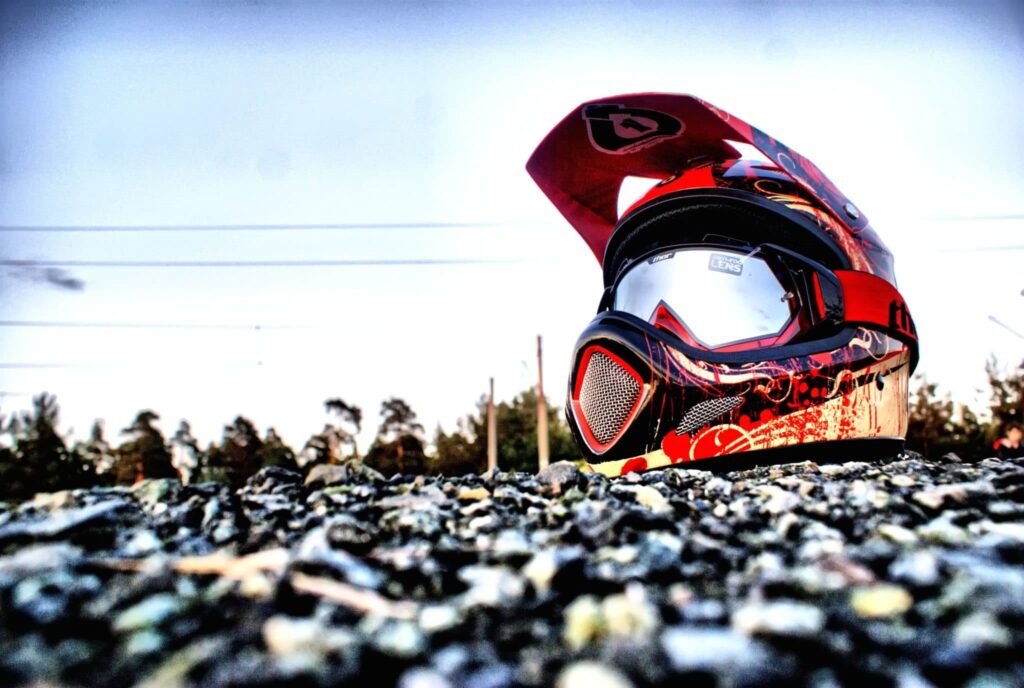What Are the Differences Between Motocross and Motorcycle Helmets?


Whether you are enjoying the open roads with a motorcycle, or exploring dirt trails and other adventures as a motocross rider, you need a helmet. There are differences between a motocross helmet and motorcycle helmet. Though each is designed to protect you as a rider, knowing how each helmet is constructed and the differences between motocross and motorcycle protection will help keep you safe.
The differences between motocross and motorcycle helmets exist because of the differences in conditions riders will meet. Motorcycle helmets are designed to keep riders protected, while maintaining visibility for the road and relief from the outdoor elements including wind. Motocross helmets are built for sport, providing airflow instead of a sealed system, and deflection from rocks, mud, and other obstacles found in a natural environment.
Street motorcycles call for aerodynamic sleekness, while motocross helmets are a bit bulkier to add protection. Motocross riders need protection from design features like chin guards, which offer ventilation and defence against front-facing crashes, for example. Some motocross helmets include a visor, designed to keep a rider free from the roost of the motocross rider ahead.
The environment of the road is different from that of an off-road experience. Motorcycle riders want to be as safe as possible on a busy road with vehicles of all types.
Because motorcycle helmets are designed to be sleek and aerodynamic, a crashed rider’s helmet will glide along the road without catching on protrusions like visors. A motocross helmet, in this situation, would be more likely to cause injury. It is not designed to slide in a crash. Many motorcycle helmets are built with high-speed impact protection at the forefront.
As for regular riding, even without worrying about a crash, that aerodynamic design matters. It keeps riders safe from the fatigue that could develop with a more wind-resistant motocross helmet. That enclosed, aerodynamic design reduces noise while motorcyclists are enjoying the road. Wind noise can be loud, especially at higher speeds, but a good motorcycle helmet dampens the noise by design. Conversely, a motocross helmet may be designed to let noise in so racers can hear where their opponents are.
A motocross helmet is not made for long-distance riding, but rather, for those quick, exciting trails and off-road adventures. If a motocross rider tried to wear a street helmet, they would quickly find that there is simply not enough mud and dust protection. Using the more sealed motorcycle helmet system, a motocross rider would lose visibility rapidly as dust and dirt made their way into the helmet. While street helmets do have some ventilation, it is not to the same degree as a motocross helmet.
Another critical difference: motocross helmets are designed to allow space for riding goggles. While motorcycle riders will get the most protection from a full-face helmet, motocross users 48420
are better off with riding goggles. These fit tightly over the face, offering refuge from dust, accommodated by a large opening in the helmet. It is important to know that helmets with a visor aren’t built for eye protection as a standalone but, rather, give some potential visibility benefits.
And, without the ventilation of a purpose-built motocross helmet, riders would also lose visibility from fogging. Motocross is a heavily physical activity. Especially on hot or challenging rides, you can’t avoid sweat. That’s why motocross helmets are made with large vents, including one in the chin guard, to promote circulation and constant visibility.
Of course, with all of that dust, dirt, and sweat, riders will want a motocross helmet that is easy to clean. Often, motocross helmets are designed with ease of cleaning in mind, versus motorcycle helmets that may not need frequent scrubbing. Look for a motocross helmet with removable pads.
There is an option in between motocross and motorcycle helmets, for those who ride both on and off-road. For those who do a fair amount of each type of riding, it may still be worth investing in both a motocross and motorcycle helmet. For those who are dabbling, the dual sport helmet may be a solution.
Dual sport helmets usually come with a visor, though it is smaller than a motocross helmet visor. A slightly extended chin guard offers more protection than a standard street helmet, albeit not as much as a strict motocross helmet. Riders can typically wear this helmet with motocross goggles or use a face shield included with the helmet. Ventilation and airflow are more than one would find in a regular motorcycle helmet, too.
With this information, you can choose the best helmet for your needs. The right helmet will marry safety with the appropriate levels of ear and eye protection, visibility, and comfort. Whichever helmet you choose, be sure that it meets US Department of Transportation safety standards and is DOT certified.
Disclaimer: While we endeavor to keep the information on our blog up to date and correct, Maxtrade (Coolster) makes no representations or warranties of any kind, express or implied about the completeness, accuracy, reliability, suitability, or availability with respect to the website or the information, products, services, or related graphics contained on the website for any purpose. Any reliance you place on such material is therefore strictly at your own risk.